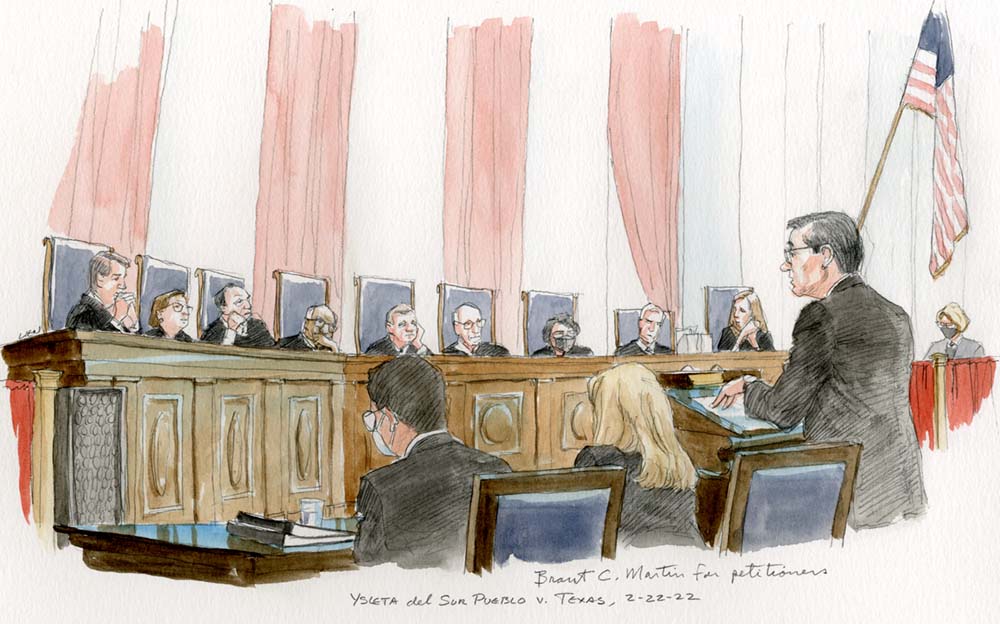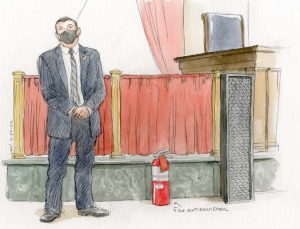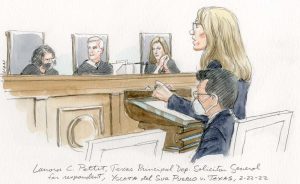A VIEW FROM THE COURTROOM
Just say “Bingo!” Or “Dingo!”

on Feb 22, 2022 at 10:18 pm

A View from the Courtroom is an inside look at oral arguments and opinion announcements unfolding in real time.
As some Supreme Court podcasters have noted, Justice Stephen Breyer’s retirement announcement in late January pushed the so-called Maskgate controversy out of the spotlight.
Today, the justices return to the bench after their long mid-winter recess, and the question in the press room is whether Justice Sonia Sotomayor will return to the bench and other justices will be masked. The omicron variant of COVID-19 had prompted Sotomayor to participate in January’s arguments via an audio feed from her chambers, while all but one of the other justices wore masks on the bench, either some or all of the time. Justice Neil Gorsuch was the much-discussed holdout.
As we wait for the session to begin, the always astute Art Lien notices an object in the courtroom that is not usually there, at least not in so prominent a position. A fire extinguisher is resting on the floor just below and to the left of the bench. Perhaps the court has concluded that certain podcasters are in need of more fodder for their metaphors about the status of the court.

A new courtroom accessory, and its guard. (Art Lien)
Lien has, of course, quickly drawn a sketch of the fire extinguisher. He is entering his last few months of arguments before himself retiring at the end of the term. He first started sketching Supreme Court arguments in the 1977-78 term, when Regents of the University of California v. Bakke, an affirmative-action case, was decided. I would like to prevail on him to go one more term and have some symmetry by sketching the Harvard and University of North Carolina affirmative-action cases, but it seems that his mind is made up. And unlike Breyer, Lien has not conditioned his retirement date on the confirmation of a successor.
At 10 a.m., the justices — all nine of them — appear from behind the curtains. Sotomayor is back but with what appears to be double masks — a black N95 or equivalent mask on top of a light-colored surgical mask. But every other justice is without a mask today. The court has essentially ruled the omicron wave to be abated.
Sotomayor and Gorsuch, neighbors on the bench, seem to be in good spirits as they sometimes trade in conversation during today’s two arguments, both of which involve different aspects of Native American sovereignty.
The first case, Ysleta del Sur Pueblo v. Texas, provides some amusing moments and seems a good one for the justices to break out of any lethargy from their long recess. The question is whether a 1987 federal statute subjects certain Indian tribes in Texas to that state’s entire body of gambling law. And the key practical effect is whether the Ysleta del Sur Pueblo and the Alabama-Coushatta tribes may operate bingo games on their reservations.
Although the court has ruled before on Indian tribes and bingo, notably in a 1987 case from California that is central to the Texas case, my immediate thought goes to the late Justice Antonin Scalia, who in a 1988 argument told the lawyer before him to “Just say ‘Bingo!’ or something” when he located a particular phrase in a lower-court opinion. (It was one of Scalia’s top quips in a SCOTUSblog compilation after the justice died six years ago this month.)
In this case, it is two forms of bingo at the Pueblo tribe’s Speaking Rock Entertainment Center near El Paso, Texas, that is primarily at issue. The center offers a more traditional type of “live call” bingo as well as electronic bingo machines that one state official said look and sound like “Las Vegas-style slot machines.” Rather than run on randomly generated numbers, they use historical bingo draws. Texas sued to block the bingo-themed center, arguing that both live call and the bingo machines violate state law, which authorizes bingo only for certain charitable groups.
“I’m pretty curious,” Chief Justice John Roberts says. “You walk in, this thing looks like a slot machine, right?”
Brant Martin, representing the Pueblo, says no.
“I think the state of Texas thinks it looks like a slot machine,” he says. “I would say it looks like an electronic bingo machine that has a bingo —”
Roberts interrupts him to ask, “What makes it look like a bingo machine?” There are about 15 law clerks present this morning, and they are audibly amused by this line of questioning.
Justice Samuel Alito says he is puzzled by “how a court is going to decide whether these machines, which I don’t have a very clear picture of in my mind, are bingo or not bingo.
If they are not bingo, they’re something else. Let’s say they’re ‘dingo.’”
This further cracks up the law clerks, and Alito runs with it.
“How is the person who has to decide this going to decide whether this thing that’s not exactly — it’s not the kind of bingo, you know, that you expect people to be playing in church, or at the Elks. It’s something different. How do you decide whether that’s bingo?”
Martin says that both Texas and federal law have definitions of bingo.
Breyer suggests consulting a higher authority.
“Can we ask my grandmother?” he says, to more laughter.
Anthony Yang, an assistant to the U.S. solicitor general arguing in support of the tribes, offers a more down-to-earth take, after Gorsuch asks him the difference between “bingo and dingo.”
“Well, I’d not heard of dingo, but I can tell you that bingo has three primary characteristics,” Yang says. “One, you have a card bearing numbers or designators. Two, you cover those numbers when they are drawn or somehow identified. And you win by covering an arrangement of numbers.”
Lanora Pettit, the principal deputy solicitor general of Texas, defends a lower-court ruling in favor of the state by saying, “We have a strong public policy and all gambling is banned under the [Texas] constitution unless specifically authorized. The [state] Bingo Enabling Act specifically authorizes small-stakes bingo under very limited circumstances, as a defense to prosecution.”
Justice Amy Coney Barrett says, “I gather it’s Texas’ position that these electronic machines would not count as bingo?”

Lanora Pettit argues on behalf of Texas. (Art Lien)
“Yes, Your Honor, because they are slot machines,” says Pettit. “They do not have the competitive aspect of bingo. … You are matching numbers and the first person to reach a particular pattern wins. And here you have one card and it is an instant game that is drawn against historic bingo draw[s], and that is just not bingo.”
There are a number of more complex aspects to this case, and everyone seems to agree it is not for the Supreme Court to decide in the first instance whether the electronic devices on the Pueblo reservation are bingo machines or slot machines. But by the end of June, only one side will have filled their card with the right five (or more) numbers and be able to just say “Bingo!”


